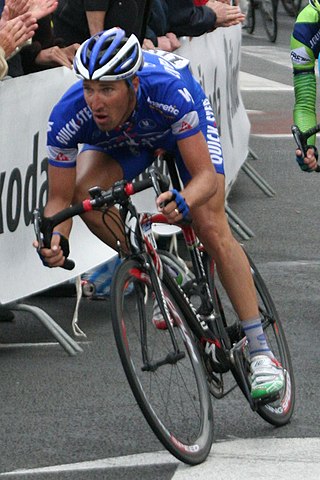Related Research Articles

Glycolysis is the metabolic pathway that converts glucose into pyruvate and, in most organisms, occurs in the liquid part of cells. The free energy released in this process is used to form the high-energy molecules adenosine triphosphate (ATP) and reduced nicotinamide adenine dinucleotide (NADH). Glycolysis is a sequence of ten reactions catalyzed by enzymes.

Adenosine monophosphate deaminase deficiency type 1 or AMPD1, is a human metabolic disorder in which the body consistently lacks the enzyme AMP deaminase, in sufficient quantities. This may result in exercise intolerance, muscle pain and muscle cramping. The disease was formerly known as myoadenylate deaminase deficiency (MADD).
The muscular system is an organ system consisting of skeletal, smooth, and cardiac muscle. It permits movement of the body, maintains posture, and circulates blood throughout the body. The muscular systems in vertebrates are controlled through the nervous system although some muscles can be completely autonomous. Together with the skeletal system in the human, it forms the musculoskeletal system, which is responsible for the movement of the body.

Lactic acid is an organic acid. It has the molecular formula C3H6O3. It is white in the solid state and it is miscible with water. When in the dissolved state, it forms a colorless solution. Production includes both artificial synthesis as well as natural sources. Lactic acid is an alpha-hydroxy acid (AHA) due to the presence of a hydroxyl group adjacent to the carboxyl group. It is used as a synthetic intermediate in many organic synthesis industries and in various biochemical industries. The conjugate base of lactic acid is called lactate (or the lactate anion). The name of the derived acyl group is lactoyl.

Lactic acid fermentation is a metabolic process by which glucose or other six-carbon sugars are converted into cellular energy and the metabolite lactate, which is lactic acid in solution. It is an anaerobic fermentation reaction that occurs in some bacteria and animal cells, such as muscle cells.

Rhabdomyolysis is a condition in which damaged skeletal muscle breaks down rapidly, often due to high intensity exercise over a short period. Symptoms may include muscle pains, weakness, vomiting, and confusion. There may be tea-colored urine or an irregular heartbeat. Some of the muscle breakdown products, such as the protein myoglobin, are harmful to the kidneys and can cause acute kidney injury.

Lactic acidosis refers to the process leading to the production of lactate by anaerobic metabolism. It increases hydrogen ion concentration tending to the state of acidemia or low pH. The result can be detected with high levels of lactate and low levels of bicarbonate. This is usually considered the result of illness but also results from strenuous exercise. The effect on pH is moderated by the presence of respiratory compensation.

Exercise physiology is the physiology of physical exercise. It is one of the allied health professions, and involves the study of the acute responses and chronic adaptations to exercise. Exercise physiologists are the highest qualified exercise professionals and utilise education, lifestyle intervention and specific forms of exercise to rehabilitate and manage acute and chronic injuries and conditions.
A cramp is a sudden, involuntary, painful skeletal muscle contraction or overshortening associated with electrical activity; while generally temporary and non-damaging, they can cause significant pain and a paralysis-like immobility of the affected muscle. A cramp usually goes away on its own over several seconds or (sometimes) minutes. Cramps are common and tend to occur at rest, usually at night. They are also often associated with pregnancy, physical exercise or overexertion, and age ; in such cases, cramps are called idiopathic because there is no underlying pathology. In addition to those benign conditions cramps are also associated with many pathological conditions.
Acidosis is a biological process producing hydrogen ions and increasing their concentration in blood or body fluids. pH is the negative log of hydrogen ion concentration and so it is decreased by a process of acidosis.
Alkalosis is the result of a process reducing hydrogen ion concentration of arterial blood plasma (alkalemia). In contrast to acidemia, alkalemia occurs when the serum pH is higher than normal. Alkalosis is usually divided into the categories of respiratory alkalosis and metabolic alkalosis or a combined respiratory/metabolic alkalosis.
Delayed onset muscle soreness (DOMS) is the pain and stiffness felt in muscles after unaccustomed or strenuous exercise. The soreness is felt most strongly 24 to 72 hours after the exercise. It is thought to be caused by eccentric (lengthening) exercise, which causes small-scale damage (microtrauma) to the muscle fibers. After such exercise, the muscle adapts rapidly to prevent muscle damage, and thereby soreness, if the exercise is repeated.
Muscle fatigue is when muscles that were initially generating a normal amount of force, then experience a declining ability to generate force. It can be a result of vigorous exercise, but abnormal fatigue may be caused by barriers to or interference with the different stages of muscle contraction. There are two main causes of muscle fatigue: the limitations of a nerve’s ability to generate a sustained signal ; and the reduced ability of the muscle fiber to contract.

Anaerobic exercise is a type of exercise that breaks down glucose in the body without using oxygen; anaerobic means "without oxygen". This type of exercise leads to a buildup of lactic acid. In practical terms, this means that anaerobic exercise is more intense, but shorter in duration than aerobic exercise.

Phosphofructokinase deficiency is a rare muscular metabolic disorder, with an autosomal recessive inheritance pattern. It is characterized as a deficiency in the Phosphofructokinase (PFK) enzyme throughout the body, including the skeletal muscles and red blood cells. Phosphofrucotkinase is an enzyme involved in the glycolytic process. The lack of PFK blocks the completion of the glycolytic pathway. Therefore, all products past the block would be deficient, including Adenosine triphosphate (ATP).
A charley horse is an American term for a very painful involuntary cramp, most commonly occurring in the legs and/or foot, lasting anywhere from a few seconds to a couple of days. The phrase formerly referred more commonly to bruising of the quadriceps muscle of the anterior or lateral thigh, or contusion of the femur, that commonly results in a haematoma and sometimes several weeks of pain and disability. In this latter sense, such an injury is known as dead leg.

The Cori cycle, named after its discoverers, Carl Ferdinand Cori and Gerty Cori, is a metabolic pathway in which lactate, produced by anaerobic glycolysis in muscles, is transported to the liver and converted to glucose, which then returns to the muscles and is cyclically metabolized back to lactate.
Muscle weakness is a lack of muscle strength. Its causes are many and can be divided into conditions that have either true or perceived muscle weakness. True muscle weakness is a primary symptom of a variety of skeletal muscle diseases, including muscular dystrophy and inflammatory myopathy. It occurs in neuromuscular junction disorders, such as myasthenia gravis. Muscle weakness can also be caused by low levels of potassium and other electrolytes within muscle cells. It can be temporary or long-lasting. The term myasthenia is from my- from Greek μυο meaning "muscle" + -asthenia ἀσθένεια meaning "weakness".

Lactate dehydrogenase (LDH or LD) is an enzyme found in nearly all living cells. LDH catalyzes the conversion of pyruvate to lactate and back, as it converts NAD+ to NADH and back. A dehydrogenase is an enzyme that transfers a hydride from one molecule to another.
Exertional rhabdomyolysis (ER) is the breakdown of muscle from extreme physical exertion. It is one of many types of rhabdomyolysis that can occur, and because of this, the exact prevalence and incidence are unclear.
References
- 1 2 "Why am I sore after exercise? Should I workout with sore muscles?". www.cfaortho.com. Retrieved 2024-04-11.
- ↑ Nelson, Nicole L.; Churilla, James R. (August 2016). "A narrative review of exercise-associated muscle cramps: Factors that contribute to neuromuscular fatigue and management implications: Exercise-Associated Muscle Cramps". Muscle & Nerve. 54 (2): 177–185. doi:10.1002/mus.25176. PMID 27159592. S2CID 206297548.
- 1 2 Layzer, Robert B. (November 1994). "The origin of muscle fasciculations and cramps". Muscle & Nerve. 17 (11): 1243–1249. doi:10.1002/mus.880171102. ISSN 0148-639X. PMID 7935546. S2CID 20514056.
- ↑ Myers, Jonathan; Ashley, Euan (1997-03-01). "Dangerous Curves: A Perspective on Exercise, Lactate, and the Anaerobic Threshold". Chest. 111 (3): 787–795. doi: 10.1378/chest.111.3.787 . ISSN 0012-3692. PMID 9118720.
- ↑ Herbert, Rob D; Gabriel, Michael (2002-08-31). "Effects of stretching before and after exercising on muscle soreness and risk of injury: systematic review". BMJ. 325 (7362): 468. doi:10.1136/bmj.325.7362.468. ISSN 0959-8138. PMC 119442 . PMID 12202327.